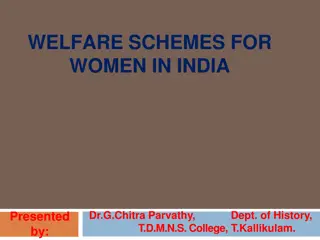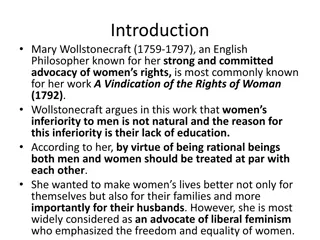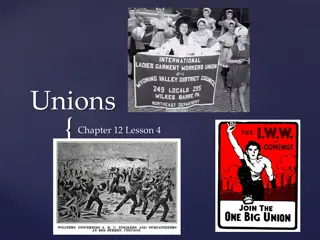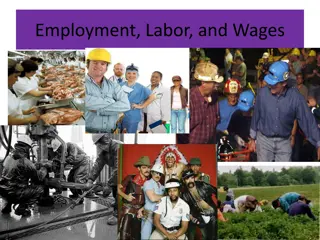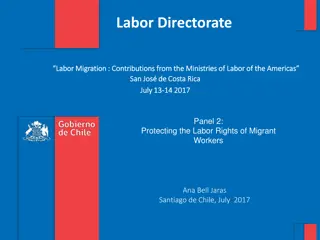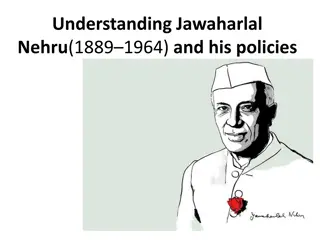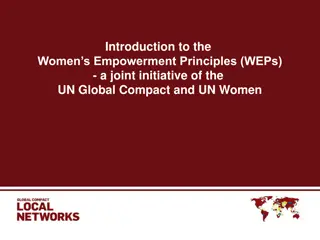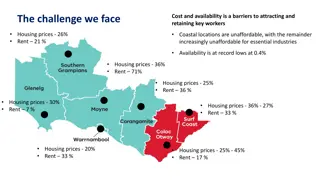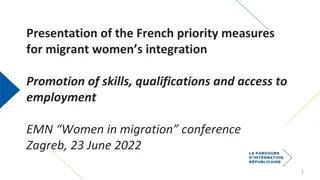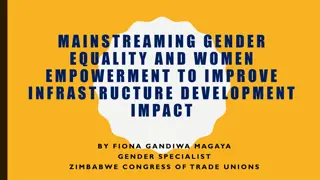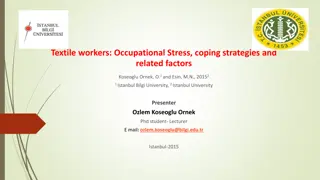Challenges and Policies in Formalising Women Workers in India
The Indian labor market faces significant challenges in formalizing women workers, with a noticeable decline in women's employment especially in rural areas. Despite recent policy attempts at formalization, such as the Unorganized Workers Social Security Act 2008 and the Maternity Benefits Act, women workers still lack advantages of formal contracts. The informal sector continues to dominate employment, posing obstacles to achieving formalization goals. New policies like demonetization and the Goods and Services Tax impact the viability of both informal and formal sectors, emphasizing the complexities in promoting formal employment.
Download Presentation

Please find below an Image/Link to download the presentation.
The content on the website is provided AS IS for your information and personal use only. It may not be sold, licensed, or shared on other websites without obtaining consent from the author. Download presentation by click this link. If you encounter any issues during the download, it is possible that the publisher has removed the file from their server.
E N D
Presentation Transcript
Women workers and the quest for formalisation The Indian experience IDEAs Panel on Gender Implications of Formalisation Policies Glasgow, 27 June 2019
Huge slack in the Indian labour market Recent absolute declines in employment, after low employment growth during boom
Big decline in womens employment, especially in rural areas Worker to population ratio, rural, 15 to 59 years Worker to population ratio, urban, 15- 59 years 90 90 82 78.4 80 80 75.2 74.2 70 70 60 60 50 50 37.2 40 40 30 30 25.5 21 19.8 20 20 10 10 0 0 Men Women Men Women 2011-12 2017-18 2011-12 2017-18
Employment in India is overwhelmingly informal, even in organised sectors Distribution of Employment Public Total employment, millions Private 500. Informal Formal Informal Formal 375. 214.2 2004-05 12.3 6.6 9.7 243.7 Unorganised Organised Total 87.7 93.4 90.3 94.5 56.5 90.8 5.5 43.5 9.16 250. 193.6 173.7 125. 2011-12 32.7 18.4 16. 12.1 16. 10.4 2004-05 0. Unorganised Organised Total 25.6 23 24.3 74.4 77 75.7 94.5 54.3 88.7 5.5 45.7 11.3 2011-12 Public organised Public unorganised Private organised Private unorganised Others
In 2017-18, most workers still had few advantages of formal contracts and women workers were generally worse off than men Rural men workers Without written contract Rural women workers 58.5 Urban men workers 72.7 Urban women workers 71.4 71.7 Not eligible for paid leave 58.1 47.9 53.1 51.8 Not eligible for any kind of social security 51.9 55.1 47 50.1
Recent policy attempts at formalisation Of workers: Unorganised Workers Social Security Act 2008 Maternity Benefits Act (1961), Amendment 2017 Pradhan Mantri MUDRA Yojana National Urban Livelihoods Mission Stand Up India Street Vendors (Protection of Livelihood and Regulations of Street Vending) Act, 2014 Employees Provident Fund Of enterprises: Demonetisation and digitisation Goods and Services Tax
The viability of informal activities is being hit by new policies, but the formal sector is simply not generating enough employment to make up Problems in agriculture and the viability of farming Demonetisation and attempt to force digital transactions that involve costs A common system of Goods and Services Tax rolled out as of 1 July 2017 Very complicated 8 different rates Adds to accounting costs of micro and small enterprises. Affects companies operating on very low margins and force shift to larger companies
Nature of respondents Age: 40% 18-30 years, 31% 31-40 years, 17% 41-50 years, 12% 50+ years. Education: More than 50% of interviewed women workers were not literate; less than 25% had higher education. 13% of men were not literate; 33% had higher education. More than 75% of interviewed workers were married: 79% of women and 73 % of men. 85% of the workers were migrants, mostly from North, East and Central states. Men workers migrated primarily for employment, women workers for marriage and then employment.
No relation between formalisation of enterprise and formalisation of work Higher percentage of men workers (73%) were employed at registered enterprise as compared to women (40%) But more than 50% of casual workers were working in registered enterprises, so work in the formal sector did not ensure formal employment conditions. Even in formal enterprises, basic laws like minimum wage laws did not apply.
Violation of minimum wages laws in the formal sector In registered enterprises, 50% of the women and 45% of the men workers were earning less than minimum wages. Percentage of workers in the registered enterprise earning below minimum wages Occupation Casual Labour Regular/ Salaried Self Employed Total Percentage 77.8 62.5 20 50 This was true of casual workers (more than 70% of women and 33 of men) and regular workers (more than 60%) Female Casual Labour Regular/ Salaried Self Employed 33.3 62.5 42.9 The difference was sometimes as much as half the minimum wage! Selfemployed: homebased Total 33.3 45.5 Male
Lack of social security Only 12% of women and 17% of men workers got any social security provisions from employers. Casual workers and home based workers were the most vulnerable in terms of lack of social security. More men workers (20%) had access to private social security than women (9%) Only 5% of the workers (all women) got some social security benefits from government sources. There was significant lack of awareness of rights and entitlements of social security, and many did not know that they would receive some provident fund benefits after contributions they thought it was must another tax.
Paid leave and written contracts Of the regular workers, only 56% of women and 50% of men had four days of paid leave in a month. Only 43% of the women and 50% of the men regular workers had written contracts. None of the casual workers (men or women), home based workers and recently unemployed (in their previous employment) had written contracts.
Union participation Of the 120 workers interviewed only 18 workers (15 per cent) were a part of a union, 16 women and 2 men. Of these 18 workers, 12 were street vendors, 5 were regular/salaried workers and 1 was a casual worker. The home-based workers interviewed didn t have any union/association, despite working in the same locality. The workers associated with a union were found to be more empowered, but they were in minority even in regular/salaried work.
Labour market fluidity Movement of daily wagers in and out of regular employment among factory workers in Kapashera area. All surveyed workers had at some point been fired without notice and lost access to social security benefits provided by the previous employer. These workers then entered the group of daily wagers, looking for work on a daily basis, without access to the wages, social security or benefits they had earlier enjoyed. Woman migrant who came to Delhi 3 years ago, in 2018 was casual worker in Jan-Feb, then regular work as a security guard Apr-June; had to return to village for personal reasons in July so lost that job, now seeking casual work. Woman salesperson at a leading Indian supermarket chain, employed by different brands active at the supermarket. So same workplace and conditions, but wages and social security benefits varied according to the brands (which changed over months, weeks or even days).
Overtime Wages Workers are entitled to double wages for their over time work. But only 20% of men workers and 15% of women workers got any overtime pay, and most got only the regular wage rather than double the rate. 7% of men and 11% of women worked overtime without any additional payment. 18% of workers did not work overtime, while a small minority (less than 2%) who were willing to work overtime were not given such opportunities. Self-employed workers tended to work long hours well beyond the stipulated work week
Conclusions - 1 Most official measures designed to increase formalisation of the Indian workforce have essentially failed. Macroeconomic measures like demonetisation have affected viability of informal activities. Many government schemes to provide some formal sector-type benefits to workers such as pensions are merely limited substitutes for formalisation, but these are often mistakenly identified as evidence of formalisation. Trying to formalise enterprises rather than workers can be detrimental to workers, negatively affecting their livelihood and employment. E.g. demonetisation and GST.
Conclusions - 2 Measures of formalisation (such as paid leave or social security or written contract) inadequate to measure decent work, since even workers with one or more of these indicators face extreme insecurity of tenure and exploitation. Fake formalisation , when either informal enterprises get subsumed in formal enterprises or workers are classified as formal without really getting any associated protection/benefits Labour market fluidity leads to the movement of workers across unorganised/organised sectors with only transient benefits, without real changes in their basic situation and conditions.
Conclusions - 3 Women workers are often the worst affected by formalisation measures because of the gender blindness of many measures. Even well-meaning measures to improve conditions of working women (such as maternity benefit laws) can operate against their interests in some contexts. Lack of awareness of many laws and schemes, and difficulty of accessing entitlements, still operate against the interests of informal workers, and especially women. Public employment can set a positive trend or make a bad situation worse ( voluntary workers ). Association, mobilisation and unionisation can be crucial in affecting awareness and demands for rights.










